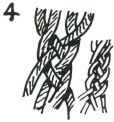For grass rope, the strand should not be more than ¼-inch diameter, for coarse bark or palm not more than 1/8 or 3/16, for fine bark, hair or sisal fibre not more than 1/8 inch.
For cords the strand should be no more than one-sixteenth inch in diameter.
Fine cords cannot be made from grass, unless the fibres are separated by beating out and ‘combing.’
The correct amount of twist is when the material is ‘hard,’ that is, the twist is tight.
FAULTS COMMON WITH BEGINNERS
There is a tendency with the beginner to feed unevenly. Thin wispy sections of strand are followed by thick hunky portions. “ Such feeding is useless. Rope made from such strands will break with less than one-quarter of the possible strain from the material.
The beginner is wise to twist and feed slowly, and to make regular, even strands rather than rush the job and try and make the strands quickly. Speed, with uniformity of twist and thickness, comes only with practice. In a short time when you have the ‘feel’ of feeding, you will find you can feed at the rate of from thirty to sixty feet a minute.
Thick strands do not help. It is useless to try and spin up a rope from strands an inch or more in thickness. Such a rope will break with less than half the potential strain of the material.
Spinning ‘thick’ strands does not save time in ropemaking.
LIANAS, VINES AND CANES
Lianas and ground vines are natural ropes, and grow in sub-tropical and tropical scrub and jungle. Many are of great strength, and useful for bridging, tree climbing and other purposes. The smaller ground vines when plaited give great strength and flexibility. Canes, and stalks of palms provide excellent material if used properly. Only the outer skin is tough and strong, and this skin will split off easily if you bend the main stalk away from the skin. This principle also applies to the splitting of lawyer cane (calamus), all the palm leaf stalks and all green material. If the split starts to run off, you must bend the material away from the thin side, and then it will gradually gain in size, and come back to an even thickness with the other split side.

BARK FIBRES
The fibres in many barks which are suitable for rope making are close to the innermost layer. This is the bark next to the sap wood.
When seeking suitable barks of green timber, cut a small section about three inches long, and an inch wide. Cut this portion right from the wood to the outer skin of the bark.
Peel this specimen, and test the different layers. Green bark fibres are generally difficult to spin because of ‘gum’ and it is better to search around for windfallen dead branches and try the inner bark of these. The gum will probably have leached out, and the fibres separate very easily.
Many shrubs have excellent bark fibre, and here it is advisable to cut the end of a branch and peel off a strip of bark for testing. Thin barks from green shrubs are sometimes difficult to spin into fine cord and it is then easier to use the lariat plait for small cords.
Where it is necessary to use green bark fibre for rope spinning (if time permits), you will find that the gum will generally wash out when the bark is teased and soaked in water for a day or so.
After removing from the water; allow the bark strips to partly dry out before shredding and teasing into fibre.
PLAITING
One man may require a considerable length of rope, and if he has no assistance to help him spin up his material he can often find reasonably long material (say, from 1 ft. to 3 ft. or more) and using this material he can plait (or braid) and so make suitable rope. The usual three plait makes a flat rope, and while quite good, has not the finish or shape, nor is it as ‘tight’ as the four or lariat plait. On other occasions it may be necessary to plait broad bands for belts or for shoulder straps. There are many fancy braids and plaits which you can develop from these, but these three are basic, and essential for practical woodcraft work.
A general rule for all plaits is to work from the outside in to the centre.
THREE PLAIT
Take the right-hand strand and pass it over the strand to the left.
Take the left-hand strand and pass it over the strand to the right and repeat alternately from left to right.

FLAT FOUR PLAIT

Lay the four strands side by side. Take the right-hand strand as in Fig. 1 and lay it over the strand to the left.

Now take the outside left-hand strand as in Fig. 2 and lay it under the next strand to itself and over what was the first strand.

Take the outside left strand and put it under and over, the next two strands respectively moving towards the right.

Thereafter your right-hand strand goes over one strand to the left, and your lett-hand strand under and over to the right, as shown in Fig. 4.
BROAD PLAIT

To commence. Take six, seven or more strands, and hold them flat and together.
Take a strand in the centre and pass it over the next strand to the left, as in Fig. 1.

Take the second strand in the centre to the left and pass it towards the right over the strand you first took so that it points towards the right as in Fig.
1 comment